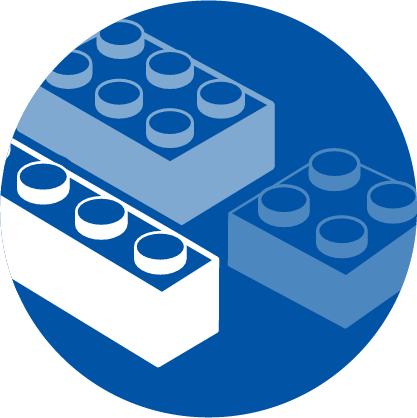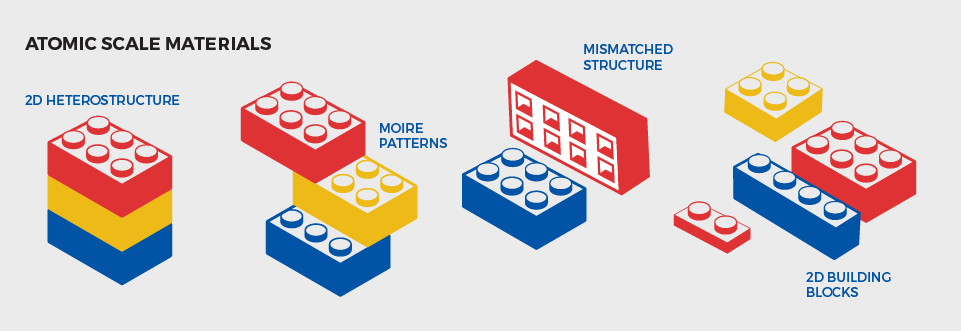

WHAT ARE QUANTUM MATERIALS?
These are materials where the extraordinary effects of quantum mechanics give rise to exotic and often incredible properties. While all materials exhibit quantum mechanical properties at some level, ‘quantum materials’ exhibit unique properties like quantum fluctuations, quantum entanglement, quantum coherence, and topological behavior.
OUR FOCUS
A central focus of our research group is to describe, from first principles, the microscopic dynamics, decoherence and optically-excited collective phenomena in materials at finite temperature (that is, including phonons ab initio) to quantitatively link predictions with 3D atomic-scale imaging, quantum spectroscopy and (subsequently) macroscopic device behavior. Capturing these dynamics poses unique theoretical and computational challenges; the simultaneous contribution of processes that occur on many time and length-scales have remained elusive for state-of-the-art computational materials and model Hamiltonian approaches alike, necessitating the development of new methods.
OUR WORK ON QUANTUM MATERIALS
The physics of quantum materials is rich with spectacular excited-state and nonequilibrium effects, but many of these phenomena remain poorly understood and consequently technologically unexplored. Our research, therefore, focuses on: how do quantum-engineered materials behave, particularly in their excited and nonequilibrium state, and how can we harness these effects? By developing predictive theoretical and computational approaches to study dynamics, decoherence and correlations in materials, our work will enable technologies that are inherently more powerful than their classical counterparts ranging from scalable quantum information processing to ultra-high efficiency optoelectronic and energy conversion systems. At the quantum limit, these technologies could underpin the next revolution in our world’s energy, computing and information infrastructure. To enable this ambitious program, our group is inherently interdisciplinary: we work across high-performance computing, materials theory, condensed matter physics, and computational chemistry and collaborate closely with experimental groups to connect predicted properties with cutting-edge measurements.
OUR WORK ON LOW DIMENSIONAL QUANTUM MATERIALS
2D materials and van der Waals heterostructures allow us to play with legos at an atomic-scale. These stacked 2D materials or van der Waals heterostructures have generated considerable recent interest as designer photonic and optoelectronic quantum materials. Much like legos, they could stack perfectly or be slightly mismatched (strained) or have strong mismatch effects like Moire periodicity. The ability to directly fabricate structures with atomic precision suggests a new path toward realizing more resilient quantum devices. However, so far, work in this field has been led by experiments and concomitant simulations. This is where our work comes into the picture! We are developing computational tools and a predictive understanding of quantum materials. Combining the power and possibilities of excited-state and heterostructure engineering with the collective and emergent properties of quantum materials, quantum-matter heterostructures open a new field of materials physics.
OUR WORK ON LINEAR-, NONLINEAR- & HYDRODYNAMICS IN QUANTUM MATERIALS
A central problem in electronic structure simulations of excited states is capturing the dynamical interaction of electrons and phonons in quantum materials without approximating the phonon behavior. While much work has been done on the analytical treatment of the electron-phonon interaction, a computational implementation is essential for prediction of lifetimes and transport in real materials. To this end, our group has pioneered the field of ab initio calculations of phonon-assisted excitations in metals, Weyl semimetals and mixed dimensional-layered quantum materials and led the field in calculations of energy-dependent lifetimes and mean free paths of excited carriers, accounting for electron-electron and electron-phonon scattering. This work has provided essential theoretical insight into transport in materials showing hydrodynamic electron flow as well as in characterizing non-equilibrium and optically-generated carrier dynamics including linear and nonlinear processes at the nano-mesoscale. In tandem, we have introduced a new transport framework to study phonon transport across semi-coherent and coherent interfaces, retaining atomic-scale detail and microscopic scattering information.
We have an active effort on how to model quantum defects in solids (“artificial atoms in solids”) such that we can guide the development of next-generation scalable quantum systems. Through ab initio calculations and new theoretical methods, we are working towards artificial atoms with desired quantum properties that advance artificial quantum coherent systems.
Our group currently has an Army Research Office funded MURI (Ab Initio Solid-State Quantum Materials) on design of new quantum emitters in 2D materials and a recently awarded (2021) Office of Naval Research MURI on “Topological Spin Qubits Based on Graphene Nanoribbons”. With colleagues at Oakridge National Lab (ORNL) we are supported by the Department of Energy Basic Energy Sciences QIS grant on “Atom-by-atom design and fabrication of new quantum technologies”. We also received an NSF CAREER Award for “First Principles Design of Error-Corrected Solid-State Quantum Repeaters” in 2020. Our group is part of the Center for Quantum Networks (NSF ERC, awarded in 2020) and an NSF QuIC TAQS program on “Deterministically Placed Nuclear Spin Quantum Memories for Entanglement Distribution”.
This is a rapidly expanding field. Here’s a Perspective by Dr. John Philbin and Prof. Prineha Narang on “Computational Materials Insights Into Solid-State Multiqubit Systems” published in PRX Quantum in September 2021. From the Popular Summary, “In this Perspective, we break down the challenges associated with modeling quantum phenomena in multiqubit solid-state material systems, leveraging advances in high-performance supercomputing and algorithms in computational physics.” Further “We provide a forward-looking view on how recent advances at the intersection of materials physics and quantum information can accelerate the discovery and development of new and improved solid-state qubits. In particular, we present new computational approaches for performing large-scale simulations of multiqubit systems using ab initio methods, quantum embedding methods, and open quantum system techniques.”
Recent Papers
- Head-Marsden, K., Flick, J., Ciccarino, C.J. & Narang, P. (2021). Quantum Information and Algorithms for Correlated Quantum Matter. Chemical Reviews, 121, 5, 3061-3120.
- Tian, X., Kim, D.S., Yang, S., Ciccarino, C.J., Gong, Y., Yang, Y., Yang, Y., Duschatko, B., Ajayan, P.M., Idrobo, J-C., Narang, P., & Miao, J. (2020). Correlating 3D crystal defects and electronic properties of 2D materials at the single-atom level. Nature Materials 19, 867 – 873, published March 2020, highlighted in ‘News and Views’ Article titled ‘A 3D map of atoms in 2D materials’.
- Hayee, F., Yu, L., Zhang, J.L., Ciccarino, C.J., Nguyen, M., Marshall, F., Aharonovich, I., Vuckovic, J., Narang, P., Heinz, T.F, & Dionne, J.A. (2020). Correlated optical and electron microscopy reveal the role of multiple defect species and local strain on quantum emission. Nature Materials 19 (5), 534 – 539.
- Narang, P., Ciccarino, C.J., Flick, J. & Englund, D. (2019). Quantum Materials with Atomic Precision: Artificial Atoms in Solids: Ab Initio Design, Control, and Integration of Single Photon Emitters in Artificial Quantum Materials. Advanced Functional Materials, 29 (52), 1904557.
- Ciccarino, C.J., Flick, J., Harris, I.B., Trusheim, M.E., Englund, D., & Narang, P. (2020). Strong Spin-Orbit Quenching via the Product Jahn-Teller Effect in Neutral Group IV Artificial Atom Qubits in Diamond. npj Quantum Materials, 5, 75.
- Harris, I.B., Ciccarino, C.J., Flick, J., Englund, D.R. & Narang, P. (2020). Group III Quantum Defects in Diamond are Stable Spin-1 Color Centers. Physical Review B, 102 (19), 195206.
- Trusheim, M.E., Wan, N.H., Chen, K.C., Ciccarino, C.J., Flick, J., Sundararaman, R., Malladi, G., Bersin, E., Walsh, M., Leinhard, B., Bakhru, H., Narang, P. & Englund, D. (2019). Lead-Related Quantum Emitters in Diamond. Physical Review B, 99 (7), 075430.
- Wang, D.S., Ciccarino, C.J., Flick, J., & Narang, P. (2021). Hybridized defects in solid-state materials as artificial molecules. ACS Nano.
- Chakraborty, C., Ciccarino, C.J. & Narang, P. (2020). Dynamic modulation of phonon-assisted transitions in quantum defects in monolayer transition-metal dichalcogenide semiconductors. arXiv preprint: arXiv:2007.14399.
- Grosso, G., Moon, H., Ciccarino, C.J., Flick, J., Mendelson, N., Mennel, L., Toth, M., Aharonovich, I., Narang, P. & Englund, D.R. (2020). Low-Temperature Electron-Phonon Interaction of Quantum Emitters in Hexagonal Boron Nitride. ACS Photonics, 7, 6, 1410-1417.
Topological materials science has grown as a field of research within the last decade and it was recently reported that more than a quarter of all materials have topological features. Materials are known to be topological when their electronic band structures show mathematical properties that can be linked to quantized electronic responses. In a wide range of chemical compounds, the low-energy behavior is readily explained by topological field theories that provide a high-level approach to understand many exotic material properties. Many of these material systems have been theoretically identified and experimentally verified to exhibit topological properties.
Topological materials can exhibit unusual electronic properties with analogs in high-energy physics. Among them, Weyl semimetals are promising candidates for future device applications due to their striking transport features. In candidate materials such as TaAs, NbAs, TaP and NbP, extremely high carrier mobilities and giant magnetoresistance have been reported. Our work puts a focus on the parameter-free prediction of optical and transport coefficients in these structures by developing new theoretical approaches. To model these systems at scale, we recently received a DOE INCITE Award on “Exascale Simulation of Topological Materials Dynamics” in 2020-21.
We have combined theoretical, computational and experimental efforts on Weyl semimetals to uncover the unique electronic, optoelectronic and transport properties of these materials. It is our goal to pioneer calculations of linear and higher-order optical responses in these systems, as well as to guide the search for functional materials for near-term quantum hardware.
We build our efforts on a parameter-free framework that captures temperature-dependencies and ultrafast dynamics induced by external fields. By using numerical tools that include electron-photon, electron-electron, electron-phonon dynamics, as well as far-from-equilibrium transport, we can accurately predict material properties even at elevated carrier energies.
